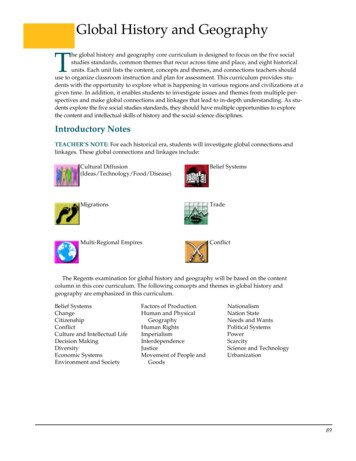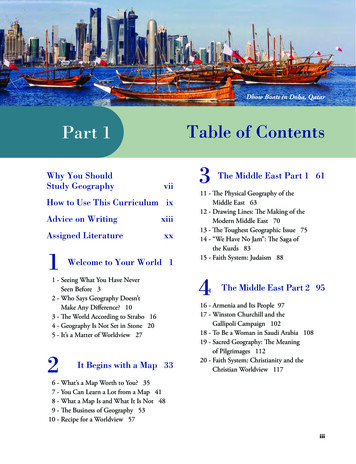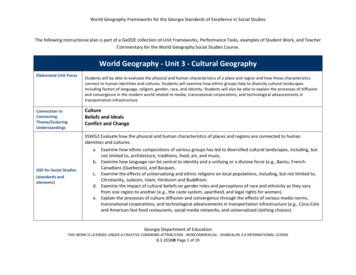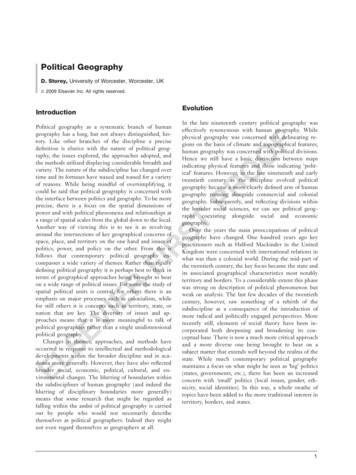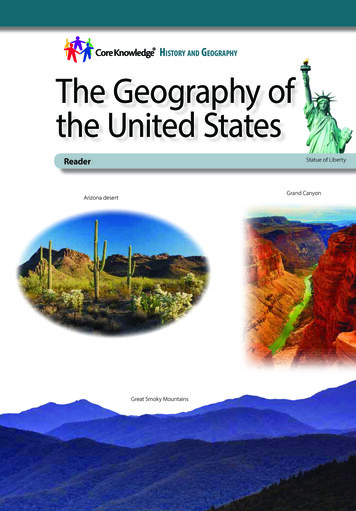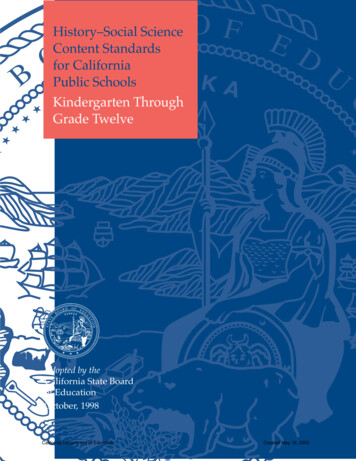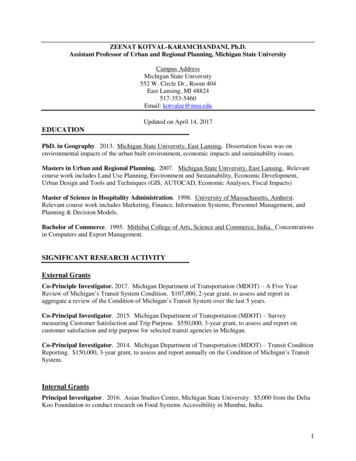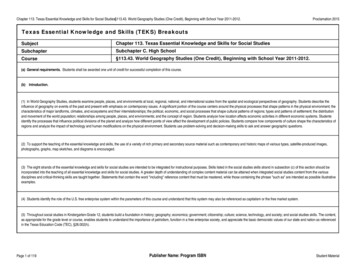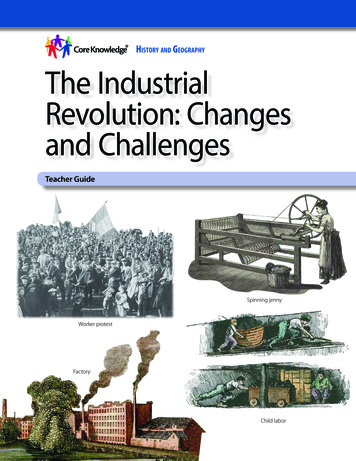
Transcription
History and GeographyThe IndustrialRevolution: Changesand ChallengesTeacher GuideSpinning jennyWorker protestFactoryChild labor
The IndustrialRevolution:Changes andChallengesTeacher Guide
Creative Commons LicensingThis work is licensed under aCreative Commons Attribution-NonCommercial-ShareAlike4.0 International License.You are free:to Share—to copy, distribute, and transmit the workto Remix—to adapt the workUnder the following conditions:Attribution—You must attribute the work in thefollowing manner:This work is based on an original work of the CoreKnowledge Foundation (www.coreknowledge.org) madeavailable through licensing under a Creative CommonsAttribution-NonCommercial-ShareAlike 4.0 InternationalLicense. This does not in any way imply that the CoreKnowledge Foundation endorses this work.Noncommercial—You may not use this work forcommercial purposes.Share Alike—If you alter, transform, or build upon this work,you may distribute the resulting work only under the same orsimilar license to this one.With the understanding that:For any reuse or distribution, you must make clear toothers the license terms of this work. The best way todo this is with a link to this web /4.0/All Rights Reserved.Core Knowledge , Core Knowledge Curriculum Series ,Core Knowledge History and Geography and CKHG are trademarks of the Core Knowledge Foundation.Trademarks and trade names are shown in this bookstrictly for illustrative and educational purposes and arethe property of their respective owners. References hereinshould not be regarded as affecting the validity of saidtrademarks and trade names.ISBN: 978-1-68380-331-7Copyright 2018 Core Knowledge Foundationwww.coreknowledge.org
The IndustrialRevolution:Changes andChallengesTable of ContentsIntroduction . . . . . . . . . . . . . . . . . . . . . . . . . . . . . . . . . . . . . . . . . . . . . . . . . . . . . . 1The Industrial Revolution: Changes and Challenges Sample Pacing Guide . . . . 16Chapter 1Effects of the Industrial Revolution . . . . . . . . . 20Chapter 2Before the Industrial Revolution. . . . . . . . . . . . . 29Chapter 3Moving Toward the Industrial Age . . . . . . . . . . 36Chapter 4From Farms to Factories and Cities . . . . . . . . . . 41Chapter 5The Rise of Capitalism . . . . . . . . . . . . . . . . . . . . . . . . . 50Chapter 6Adam Smith . . . . . . . . . . . . . . . . . . . . . . . . . . . . . . . . . . . . . 56Chapter 7Living in the Industrial Era . . . . . . . . . . . . . . . . . . . . 61Chapter 8Protesting Industrialization . . . . . . . . . . . . . . . . . . 70Chapter 9Robert Owen . . . . . . . . . . . . . . . . . . . . . . . . . . . . . . . . . . . . 76Chapter 10 Looking for a New Economic Order . . . . . . . . . 82Chapter 11 Karl Marx . . . . . . . . . . . . . . . . . . . . . . . . . . . . . . . . . . . . . . . . . 88Chapter 12 In Our Time . . . . . . . . . . . . . . . . . . . . . . . . . . . . . . . . . . . . . . 96Teacher Resources . . . . . . . . . . . . . . . . . . . . . . . . . . . . . . . . . . . . . . . . . . . . . . . . . 103
The Industrial Revolution: Changes and ChallengesTeacher GuideCore Knowledge History and Geography 6
UNIT 5IntroductionAbout This UnitThe Big IdeaThe Industrial Revolution was a time of sweeping transformation in how people worked andlived, bringing innovations and fueling debates about forms of government, economic systems,and workers’ rights.Some may point to other events, but as one looks back, no era could havemore importance than the Industrial Revolution.This revolution lured people from the land to factories and cities in massivenumbers. It changed the way people worked and lived. The introduction ofmachines allowed for quicker, more efficient production of goods. New inventions,such as the steam engine, improved the speed and efficiency of transportation.The Industrial Revolution opened doors to wealth and advancement for inventorsand investors alike. In short, this era set the stage for unparalleled economic,political, and intellectual growth that still continues today.These benefits did not come without cost. The machines and factories thatbrought great wealth to many also brought misery to others and severelydamaged the environment. Children were funneled into dangerous jobs inmines and mills, and even adult workers labored in unsafe conditions.Many voices were appalled at these negative effects of the Industrial Revolutionand spoke out against them and acted to change them. The revolutions inpolitics—seen in America and in France—coupled with the revolution inindustry, forced political attitudes to alter and adapt. Socialism, communism,unions, and strikes led to decades of periodic unrest, culminating in the RussianRevolution in 1917.As the dust settled, capitalism—regulated by the people through theirgovernments—emerged as the most successful social and economic system.INTRODUCTION1
What Students Should Already KnowStudents in Core Knowledge Schools should already be familiar with: The Renaissance, which began in Italy and eventually spread to otherparts of Europe, lasted from about 1400–1650.Time Period BackgroundThis timeline provides an overview of keyevents related to the content of this unit.Use a classroom timeline with students tohelp them sequence and relate events thatoccurred from the 1400s to the 1980s.1400s–1700sThe mercantilist theory wasthat a country could grow richand powerful by controllingtrade. If it could force rivalnations to buy its goods, itcould increase the amount ofsilver and gold it had.1600s–1700sTending to the fields,planting, and harvestingwere very important jobsfor farmers.1600s–1700sHaving enough food toeat and staying warm andhealthy were importantconcerns for poor farmersand villagers. The Renaissance was marked by a curiosity about the physical world,which was manifested in art, scientific observation, and investigation. The Renaissance overlapped the Age of Exploration, a period in whichEuropeans ventured out to explore what was to them the unknownworld, including the exploration and establishment of the British coloniesin North America. The development of moveable type by Johannes Gutenberg (in the West)made possible widespread literacy in vernacular languages. Following the Renaissance, during the historical periods known asthe Reformation and Counter-Reformation, with Europe divided intoProtestant and Catholic territories, people were more likely to questionthe authority of the Church. Interest in science and education continuedwith Copernicus’s theory of a sun-centered universe published in 1543,supported by Galileo in 1632. The Enlightenment was a historical period in the 1600s and 1700s whenpeople questioned old ideas and sought knowledge.1700smid-1700s Thomas Hobbes, an English philosopher, concluded that a strong centralgovernment was the best type of government and was essential topreventing man’s tendency for constant infighting. John Locke, another English philosopher, promoted the idea of a socialcontract to argue against the divine right of kings. He also argued thatthe human mind was like a blank slate that becomes filled during one’slifetime, based on one’s experiences. Thomas Jefferson was strongly influenced by Locke’s ideas, which arereflected in the Declaration of Independence. The Founding Fathers were also influenced by Montesquieu, a Frenchphilosopher, who argued for a balance and separation among differentbranches of government, as reflected in the U.S. Constitution. The ideas of the Enlightenment influenced people to take action inEngland (the English Civil War) and in America (the American Revolution).The same ideas, and the events in England and America, sowed the seedsfor the French Revolution. During the ancien régime, the French social classes were divided into theThree Estates, with the clergy represented in the First Estate, nobility inthe Second Estate, and common people in the Third Estate.1760s–1830s2The invention of thespinning jenny and themule dramatically changedhow cloth was created.Work moved from people’shomes to large factories.Factories becamewidespread throughoutGreat Britain during theIndustrial Revolution.1768James Watts developed amore efficient steam engineto pump water out of coalmines, making it easier todig for coal.1770sGeorge III was the kingof Britain at the time thattensions between Britainand its colonies in NorthAmerica continued to grow.1771–1858Robert Owen, an earlybeliever in socialism,worked to better livingand working conditionsfor workers.1776In 1776, British colonists inNorth America declaredtheir independence fromGreat Britain.1776Adam Smith’s The Wealth ofNations was published. In 1789, the Third Estate was transformed into the National Assembly. Ordinary people stormed the Bastille on July 14, 1789; this date is stillcelebrated in France in a way similar to July 4 in the United States.New inventions andtechniques, such as the useof energy from waterwheelsto grind more flour, madefood more abundant withless effort.THE INDUSTRIAL REVOLUTION: CHANGES AND CHALLENGES
17891792early 184818481860s–1960s1980s–?INTRODUCTIONDuring the FrenchRevolution, the stormingof the Bastille sparkedviolence in Paris andthroughout France.Eli Whitney invented thecotton gin, contributing tothe growth of slavery in theAmerican South and thegrowth of factories in England.Cities grew around newfactories. Manchester hadninety-nine cotton spinningmills by 1830.With the development of thefirst steam locomotive, bothpeople and goods could betransported more easily andfor longer distances.Benjamin Disraeli, primeminister under Queen Victoria,worked to pass laws benefitingthe working classes.By 1810, much of Europewas under the control ofFrench Emperor NapoleonBonaparte. Russia and theOttoman Empire remainedoutside of his control.Modern unions trace their rootsto the formation of workers’associations that sought toprotect workers’ rights.Charles Dickens’s novels led togreater awareness of the hardlives of the poor in England.Child labor was common incoal mines and factories.Revolutionary uprisings inFrance and across Europe:People demanded betterworking conditions, freedomof the press, and moreinvolvement in government.Karl Marx and FriedrichEngels published TheCommunist Manifesto.The second stage of theIndustrial Revolution sawincreasing numbers ofinventions and advances intransportation and medicine.Many historians believethat we have now enteredthe third stage of theIndustrial Revolution: theInformation Age. This stageis characterized by new waysof communicating, includingcell phones and social media.What Students Should Already Know CONTINUED The National Assembly wrote “The Declaration of the Rights of Man,”which limited the power of the monarchy, to which Louis XVI agreed. In 1792, the National Convention eliminated the monarchy and declaredthat France was a republic. The National Convention also tried Louis XVIfor treason. Both Louis XVI and his queen, Marie Antoinette, wereexecuted. Extreme efforts to eliminate opposition to the French Revolution by theCommittee of Public Safety and Robespierre led to the Reign of Terror. In the 1800s, France and much of Europe fell under the control of theEmperor Napoleon Bonaparte, one of the greatest military minds ofall time. Following a disastrous attempt to invade Russia, Napoleon was banishedto Elba. He managed to escape and return to Paris, only to lose the battleat Waterloo and to be banished again to St. Helena.What Students Need to LearnA. THE INDUSTRIAL REVOLUTION Beginnings in Great Britain-- Revolution in transportation: canals, railroads, new highways-- Steam power: James Watt Revolution in textiles: Eli Whitney and the cotton gin, factoryproduction Iron and steel mills The early factory system-- Families move from farm villages to factory towns-- Unsafe, oppressive working conditions in mills and mines-- Women and child laborers-- Low wages, poverty, slums, disease in factory towns-- Violent resistance: LudditesB. CAPITALISM Adam Smith and the idea of laissez faire vs. government interventionin economic and social matters Law of supply and demand Growing gaps between social classes: Disraeli’s image of “two nations”(the rich and the poor)3
What Students Need to Learn CONTINUEDC. SOCIALISM An idea that took many forms, all of which attempted to offer analternative to capitalism-- Public ownership of large industries, transportation, banks, etc., andthe more equal distribution of wealth Marxism: the communist form of socialism-- Karl Marx and Friedrich Engels, The Communist Manifesto: “Workersof the world, unite!”-- Class struggle: bourgeoisie and proletariat-- Communists, in contrast to socialists, opposed all forms ofprivate property.At a GlanceThe most important ideas in Unit 5 are:4 Before the Industrial Revolution, daily life focused on the demands offarming and an agricultural society. New inventions and techniques during the Industrial Revolution made foodmore abundant with less effort. James Watt developed a more efficient steam engine to pump water out ofcoal mines, making it easier to dig for coal. With the development of the first steam locomotive, both people andgoods could be transported more rapidly and for longer distances. The invention of the spinning jenny and the mule dramatically changedhow cloth was created. Work moved from people’s homes to large factories. With the development of more and more factories came the developmentof large cities. Capitalism is an economic system in which resources and businesses areprivately owned and prices for goods are not regulated by government, butinstead are based on the laws of supply and demand. Socialism is an economic system in which important resources andbusinesses are owned or regulated by government. While the inventions (of the first stage) of the Industrial Revolution broughtmany advances and increased the overall quality of life for some people,they also led to increasing class differences in which many working classpeople suffered extreme poverty. Modern European countries combine aspects of capitalism with socialism.THE INDUSTRIAL REVOLUTION: CHANGES AND CHALLENGES
What Teachers Need to KnowTechnology Changes the WorldThe Steam Engine Leads to Big ChangesThe steam engine developed by James Watt helped usher in an extraordinarychange in how humans work and live. Versions of steam engines had beendesigned previously: in ancient Rome, in Egypt in the 1500s, and in the 1600sand 1700s in Spain, Italy, Germany, and England. Watt made some key technicalimprovements that greatly increased the efficiency and power of steamengines. These new engines led to the rapid invention of machines that coulddo work that had previously been done using animal power, wind or waterpower, or human muscle power. The nature of work itself began to change.Factories became more and more important. Waves of people migrated fromrural, agricultural lives to cities in order to work in the new factories. Miningalso expanded due to new technology. People had previously dug mineralsout of the earth, but the developments of the Industrial Revolution meant thatmore mining could be done.Work and WorkersThe Industrial Revolution started at the end of the 1700s in Great Britain,sweeping across that country and expanding into Europe and the UnitedStates during the 1800s. People’s lives changed dramatically. New technologiesmeant that more goods could be produced and could be sold for less. Theincreased variety and affordability of goods impacted people’s lives in manyways. Business and factory owners held power and grew wealthy. However,most of the people doing the new work remained poor, because wages wereusually very low. Moreover, workers often toiled in dangerous conditions.They had few or no rights or protections and were often forced to work ten totwelve hours a day or more. Many children began work at a very young age,facing all the same difficulties that adult workers did.Reforms and DebatesOver time, reformers, some politicians, and workers themselves began to pushfor better conditions. In Britain and Europe, some laws were passed to provideminimal protections to workers and to require some education for children.Workers formed unions to try to gain some measure of power.Owners of factories, mines, and businesses objected to regulation by thegovernment, arguing that the free market should set wages and determineworking conditions. Debate and conflict developed over the role ofgovernment and how best to approach business and labor. Eventually,INTRODUCTION5
workers in the West gained protections against most of the harshest workingconditions, but the debate about the free market and government regulationcontinues to this day.Political and Economic IdeasThe changes and conflicts linked to work and workers led to the developmentof new political and economic theories. Karl Marx and Friedrich Engels proposedcommunism as a solution to the oppression of workers. Other reformersconsidered how socialism could improve people’s lives. The modern form ofcapitalism developed and came to shape how economies and businesses work.Unit ResourcesStudent ComponentThe Industrial Revolution: Changes and Challenges Student Reader—twelve chaptersTeacher ComponentsThe Industrial Revolution: Changes and Challenges Teacher Guide—twelvechapters. The guide includes lessons aligned to each chapter of The IndustrialRevolution: Changes and Challenges Student Reader, with a daily Check forUnderstanding and Additional Activities, such as vocabulary practice andliterature connections, designed to reinforce the chapter content. A UnitAssessment, Performance Task Assessment, and Activity Pages are included inTeacher Resources, beginning on page 103.»» The Unit Assessment tests knowledge of the entire unit, usingstandard testing formats.»» The Performance Task Assessment requires students to apply andshare the knowledge learned during the unit through either an oralor written presentation. In this unit, the presentation is written.»» The Activity Pages are designed to reinforce and extend contenttaught in specific chapters throughout the unit. These optionalactivities are intended to provide choices for teachers.The Industrial Revolution: Changes and Challenges Timeline Image Cards—twenty-five individual images depicting significant events and individualsrelated to the Industrial Revolution. In addition to an image, each cardcontains a caption, a chapter number, and the Big Question, which outlines6THE INDUSTRIAL REVOLUTION: CHANGES AND CHALLENGES
the focus of the chapter. You will construct a classroom Timeline withstudents over the course of the entire unit. The Teacher Guide will promptyou, lesson by lesson, as to which image card(s) to add to the Timeline. TheTimeline will be a powerful learning tool enabling you and your students totrack important themes and events as they occurred within this expansivetime period.TimelineSome advance preparation will be necessary prior to starting The IndustrialRevolution: Changes and Challenges unit. You will need to identify available wallspace in your classroom of approximately fifteen feet on which you can post theTimeline image cards over the course of the unit. The Timeline may be orientedeither vertically or horizontally, even wrapping around corners and multiple walls,whatever works best in your classroom setting. Be creative—some teachers hanga clothesline so that the image cards can be attached with clothespins!Create three time indicators or reference points for the Timeline. Write each ofthe following dates on sentence strips or large index cards: 1700s 1800s 1900sAffix these time indicators to your wall space, allowing sufficient spacebetween them to accommodate the actual number of image cards that youwill be adding to each time period as per the following diagram:1700s Chapter 1800s 5 2 2 3 4 1 3 Intro 9 Intro 6 Intro 4 1900s 3 7 Intro 4 8 7 1 10 10 11 1212You will want to post all the time indicators on the wall at the outset beforeyou place any image cards on the Timeline.1700sChapter 5INTRODUCTION1700s1700sChapter 2Chapter 21700sChapter 37
1700s1700s1700s1700sChapter 4Chapter 1Chapter 3Introduction1700s1700s1700s1700sWe hold these truths to be self-evident, that all men arecreated equal, that they are endowed by their Creatorwith certain unalienable rights, that among these arelife, liberty, and the pursuit of happiness.Chapter 9IntroductionChapter 6Introduction1800s1800sEurope in 18100500 miles0 French EmpireCountries allied with NapoleonCountries controlled60 N by NapoleonCountries at war with NapoleonNKingdom ofDenmarkandSwedenNorwayNorthSeaE1700sS15 WUnited KingdomofGreat Britainand IrelandbeRussiansiaElusEmpirePrRi Berlin WarsawBrusselsGrandConfederationDuchy ofof theWarsawVersailles ParisPragueRhineLoir e Rivenube Ri ViennaAustrianDav erFrenchEmpireHelvetic EmpireugR iveRhiueaSePortticLisbon SpainCorsicaBarcelonaElbariaMadridBlack SeaMilan Kingdom Republiciv of ItalyP o R erIllyrianMarseilleProvinces OttomanEmpireRomeNaplesSardiniaKingdomof NaplesMediterranean SeaSicilyAdalrATLANTICOCEANverAmiensrLondon45 N60 NSeaWBaltic1800sangeAeChapter 31800sChapter 71800saChapter 415 ESe0 Introduction1800s1800sChapter 48Chapter 8Chapter 7Chapter 1THE INDUSTRIAL REVOLUTION: CHANGES AND CHALLENGES
1800s1800s1800sChapter 10Chapter 101800sChapter 11Chapter 121900sChapter 12The Timeline in Relation to Content in the Student ReaderThe events highlighted in the Unit 5 Timeline are in chronological order, butthe chapters that are referenced are not. The reason for this is that the Readerorganizes events more thematically than chronologically. The events of theIndustrial Revolution, and the political and economic changes the revolutionwrought, did not occur in a clear sequence. Instead, many changes happenedsimultaneously, and many events overlapped with each other.Understanding References to Time in The Industrial Revolution: Changes andChallenges UnitAs you read the text, you will become aware that in some instances generaltime periods are referenced, and in other instances specific dates are cited.For example, Chapter 2 discusses agricultural life in England in the 1600s and1700s. Chapter 10 describes the revolutions of 1848 and the publication ofThe Communist Manifesto in that same year.Time to Talk About TimeBefore you use the Timeline, discuss with students the concept of time and howit is recorded. Here are several discussion points that you might use to promotediscussion. This discussion will allow students to explore the concept of time.1. What is time?2. How do we measure time?3. How do we record time?INTRODUCTION9
4. How does nature show the passing of time? (Encourage students to thinkabout days, months, and seasons.)5. What is a specific date?6. What is a time period?7. What is the difference between a specific date and a time period?8. What does CE mean?9. What is a timeline?Using the Teacher GuidePacing GuideThe Industrial Revolution: Changes and Challenges unit is one of nine historyand geography units in the Grade 6 Core Knowledge Curriculum Series . Atotal of twenty days has been allocated to the Industrial Revolution: Changesand Challenges unit. We recommend that you do not exceed this numberof instructional days to ensure that you have sufficient instructional time tocomplete all Grade 6 units.At the end of this Introduction, you will find a Sample Pacing Guide that providesguidance as to how you might select and use the various resources in this unitduring the allotted time. However, there are many options and ways that youmay choose to individualize this unit for your students, based on their interestsand needs. So, we have also provided you with a blank Pacing Guide that youmay use to reflect the activity choices and pacing for your class. If you plan tocreate a customized pacing guide for your class, we strongly recommend thatyou preview this entire unit and create your pacing guide before teaching thefirst chapter.Reading AloudCognitive science suggests that, even in the later elementary grades andinto middle school, students’ listening comprehension still surpasses theirindependent reading comprehension (Sticht, 1984).For this reason, in the Core Knowledge Curriculum Series, reading aloud continuesto be used as an instructional approach in these grades to ensure that studentsfully grasp the content presented in each chapter. Students will typically bedirected to read specific sections of each chapter quietly to themselves, whileother sections will be read aloud by the teacher or a student volunteer. Whenyou or a student reads aloud, always prompt students to follow along. Byfollowing along in this way, students become more focused on the text and mayacquire a greater understanding of the content.10THE INDUSTRIAL REVOLUTION: CHANGES AND CHALLENGES
Turn and TalkAfter reading each section of the chapter, whether silently or aloud, GuidedReading Supports will prompt you to pose specific questions about whatstudents have just read. Rather than simply calling on a single student torespond, provide students with opportunities to discuss the questions in pairsor in groups. Discussion opportunities will allow students to more fully engagewith the content and will bring to life the themes or topics being discussed. Thisscaffolded approach, e.g., reading manageable sections of each chapter andthen discussing what has been read, is an effective and efficient way to ensurethat all students understand the content before proceeding to the remainder ofthe chapter.Building Reading Endurance and ComprehensionThe ultimate goal for each student is to be capable of reading an entire chapterindependently with complete comprehension of the subject matter. Therefore,while it is important to scaffold instruction as described above to ensure thatstudents understand the content, it is also important to balance this approachby providing opportunities for students to practice reading longer and longerpassages entirely on their own.One or more lessons in each Grade 6 CKHG unit will be designated as anIndependent Reading Lesson in which students are asked to read an entirechapter on their own before engaging in any discussion about the chapter. Aadjacent to a lesson title will indicate that it is recommended that students readthe entire chapter independently.During each Independent Reading Lesson, students will be asked to completesome type of note-taking activity as they read independently to focus attentionon key details in the chapter. They will also respond, as usual, by writing aresponse to the lesson’s Check for Understanding.It will be especially important for the teacher to review all students’ writtenresponses to any Independent Reading Lesson prior to the next day’s lessonto ascertain whether all students are able to read and engage with the textindependently and still demonstrate understanding of the content.If one or more students struggle to maintain comprehension when asked toread an entire chapter independently, we recommend that, during the nextIndependent Reading Lesson opportunity, you pull these students into a smallgroup. Then, while the remainder of the class works independently, you canwork with the small group using the Guided Reading Supports that are stillincluded in the Teacher Guide for each lesson.INTRODUCTION11
Big QuestionsAt the beginning of each Teacher Guide chapter, you will find a Big Question,also found at the beginning of each Student Reader chapter. The Big Questionsare provided to help establish the bigger concepts and to provide a generaloverview of the chapter. The Big Questions, by chapter, are:ChapterBig Questions1How would you describe working conditions in the early part ofthe Industrial Revolution?2What was rural life like for ordinary people before the IndustrialRevolution?3In what ways did the inventions of the Industrial Revolutionimpact people’s lives?4What developments in the manufacturing of cloth caused massmigration to industrial towns and cities?5What was mercantilism?6What were Adam Smith’s basic economic beliefs?7What were the advantages and disadvantages of the industrial era?8Why did workers begin to organize themselves into groups?9What did Robert Owen do to achieve better living and workingconditions for people?10What factors within the capitalist system caused a degree ofunpredictability in relation to the well-being of the workers?11What were the basic differences between the beliefs of RobertOwen and those of Karl Marx?12How would you describe the changes taking place in the InformationAge in comparison to the first and second stages of the IndustrialRevolution?Note: You may want to suggest that students devote a separate section oftheir notebooks to the Big Questions of this unit. After reading each chapter,direct students to number and copy the chapter’s Big Question and thenwrite their response underneath. If students systematically record the BigQuestion and response for each chapter, by the end of the unit, they will have aconcise summary and study guide of the key ideas in the unit. This note will beincluded as a prompt in the first three lessons to remind you to continue thispractice throughout the unit.Core VocabularyDomain-specific vocabulary, phrases, and idioms highlighted in each chapter ofthe Student Reader are listed at the beginning of each Teacher Guide chapter,12THE INDUSTRIAL REVOLUTION: CHANGES AND CHA
Emperor Napoleon Bonaparte, one of the greatest military minds of all time. Following a disastrous attempt to invade Russia, Napoleon was banished to Elba. He managed to escape and return to Paris, only to lose the battle at Waterloo and to be banished again to St. Helena. 1789 During the French Revolution, the storming of the Bastille sparked


